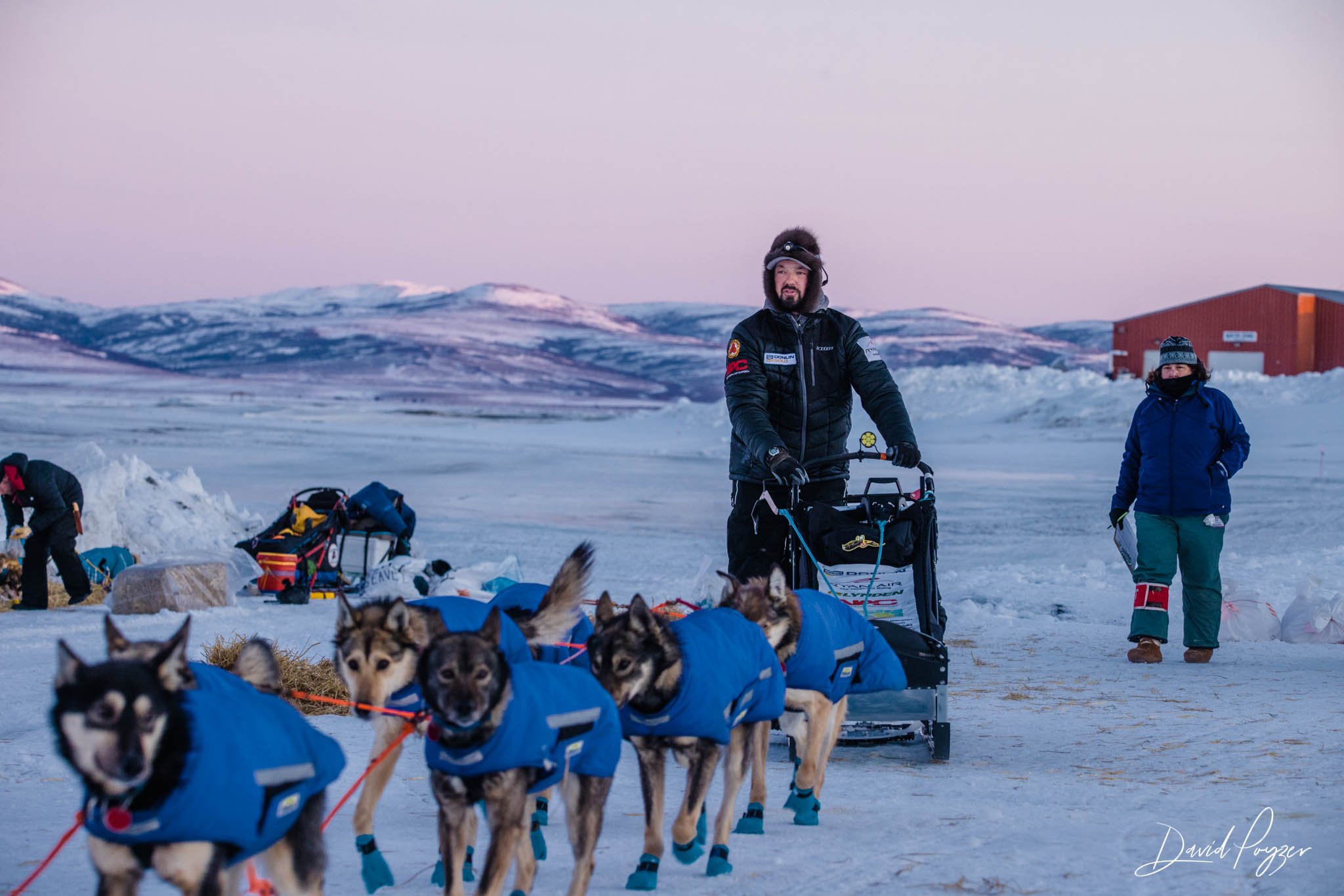The Heart of an Athlete
Iditarod Head Vet Stu Nelson at work in an Iditarod checkpoint listening to the heart of a super athlete.
Credit: Peter Varga – http://facebook/TyingKnotsArtStudios
It is obvious that we need sled dogs and dog mushers to have a sled dog race… less obvious but no less important, is the presence of veterinarians.
In the Iditarod alone, during the race more than 50 veterinarians are on the trail in the checkpoints, at the start and at the finish line to assist the dog musher in providing the best possible care for the super athletes: the dogs. According to Iditarod head veterinarian Stu Nelson, the vets come from all over the United States and as far away as Australia and South Africa to take part in Iditarod.
Vets swarm checkpoints, stethoscopes draped around their necks, calmly inspecting each and every dog, moving through dog lots, hovering over teams, gently rubbing shoulders and backs, patting the dogs' haunches, looking for any signs of distress. In total these vets will perform about 10,000 routine exams during the race, making sure the dogs remain healthy during the competition. But the work begins long before the start of the race. Sign up for Iditarod takes place end of June and as soon as musher sign up, Iditarod head veterinarian Stu Nelson makes contact, starts traveling out to kennels for kennel visits while providing a steady stream of information on the latest research and knowledge in the field of sled dog veterinary medicine.
Besides requirements on vaccinations, all dogs that participate in Iditarod go through a screening process starting in February within the month of race start in early March. Every dog, some +1000 dogs, must undergo an ECG and basic blood work to check for abnormalities.
Musher Timofei Gynuntegin with Sokk getting blood drawn to be tested.
Credit: Mille Porsild – http://facebook.com/Runningsleddogs
THE MUSHERS SIGN UP FOR A DAY TO COME IN FOR TWO HOURS TO GET THE ECG AND BLOOD WORK DONE ON UP TO 24 OF THEIR DOGS THAT ARE POTENTIAL STARTERS IN THE RACE. FIRST BLOOD IS DRAWN FROM EACH DOG.
Many hours are dedicated to analyzing the full profile of the blood test from each dog, including looking at white and red blood cell concentration, hemoglobin values, platelet counts, levels of electrolytes, varies enzymes, minerals and waste products. All results are reviewed and checked for any values that may warrant the need for immediate attention. Any critical results are faxed or called to the chief veterinarian, who will then contact the musher to discuss the findings. Copies of each team's results are mailed to both the musher and Chief Veterinarian.
It is costly and takes a large team of dedicated coordinators, veterinary technicians, data entry personnel, clinical laboratory assistants, medical laboratory technicians, medical technologists and veterinarians to make this happen. But performing all of these blood tests, provide an incredible amount of information to learn about the health of the sled dogs in general on a continues basis; And it is a magnificent tool for both mushers and veterinarians to utilize in their kennel management.
At the same time blood is drawn the dogs are checked for or given a microchip inserted under the skin so that their chip number can easily identify each dog with the chip scanner.
Credit: Mille Porsild – http://facebook.com/RunningSleddogs
Kusko on the table in skilled hands, the electrodes attached getting his ECG monitoring his heart for any abnormalities.
Credit: Mille Porsild – http://facebook.com/RunningSleddogs
After the blood draw, each dog is given an ECG. This is the process of recording the electrical current generated by the heart muscle as it beats. The medical instrument that actually does the recording is known as an electrocardiograph. The recorded tracing is called an electocardiogram (ECG).
The recording is made by lying the dog on its side and attaching small clips to each of the four legs and to the chest wall. The process is painless and takes about five minutes to complete.
The ECG shows upward and downward tracings that reflect the alternate contraction of the atria and ventricles in the heart. The information that can be obtained from the ECG includes heart size, rate and rhythm. Abnormal rhythms are known as “arrhythmias.”
The staff members evaluate each ECG for any abnormalities that might jeopardize a dog. Criteria are based primarily on known risk factors for human athletes. It is very uncommon, but when a dog is determined to have a potentially serious arrhythmia, it will not be allowed to start in the race and the musher is informed of the condition with an appropriate recommendation for follow-up care.
Sled dogs preparing to enter a 1000-mile long-distance race are highly conditioned marathon athletes. Iditarod has been doing this as part of an ongoing study for over twenty years to learn more about the hearts of these super athletes. As it turns out, similar and normal changes occur in the heart muscles of these dogs and human distance runners. As we all know, if you exercise your muscles, they become stronger and larger. The ECG is showing us that this is essentially what happens in the heart of these endurance athletes.



































